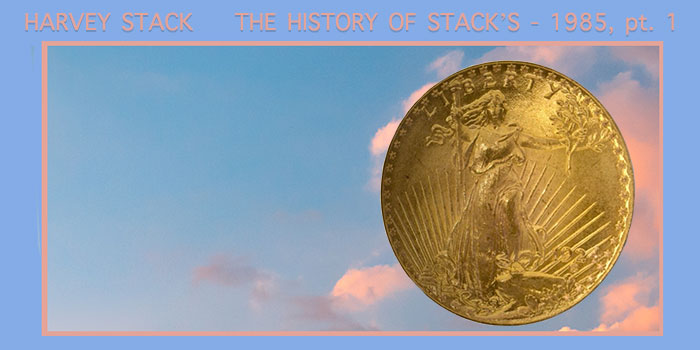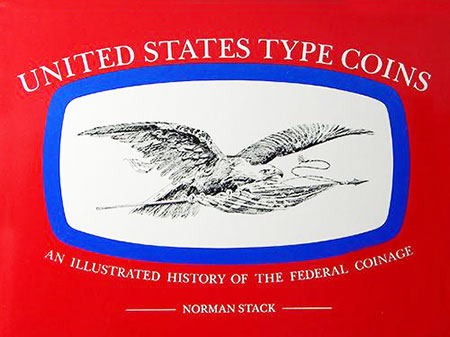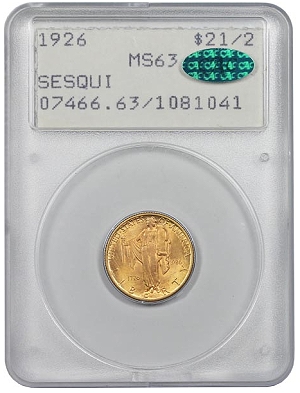
By Harvey Stack – Co-Founder, Stack’s Bowers Galleries ……
Another Year of Change
Like the year before, 1985 was another major year for the hobby as it changed and adopted new guidelines for dealer and collector activity.
The precious metals markets–especially for silver–calmed down after the loss of the fortunes that the Hunt Brothers had accrued at the beginning of the decade and the time to recoup had begun. Collectors trying to add to their collections came back to the market as silver prices returned to earlier values.
New Strength in the Grading Service Market
Another encouraging trend bringing collectors back to the market was the growth in third-party grading services. Introduced by the American Numismatic Association (ANA), who provided the authentication of coins for a small fee and combined both a NUMERICAL and an ADJECTIVAL grade to describe the strike and condition of the coin, submissions had become so extensive by the mid-1980s that two different professional groups created additional services–PCGS (Professional Coin Grading Service) and shortly thereafter NGS (Numismatic Grading Service)–were formed, each providing assurances like ANACS did but more efficiently and with a faster turnaround. These services grew quickly, giving collectors the confidence to buy and helping the hobby to grow into what it is today.
Wall Street and Tangible Collectibles
Then the famous stock brokerage house Salomon Brothers got interested in learning more about the various collectible markets and engaged various expert firms in providing a market index for collectibles, publishing it for 11 years starting in the early 1980s. Stack’s, which was already a major numismatic firm and auctioneer, was asked to develop a portfolio and submit any growth or drop in value that occurred each year. Norman and I, who were the major partners in Stack’s at the time, accepted the job, but since more than one coin by grade or importance in rarity could influence any given market, we decided to create a TYPE SET.
Using some 20 coins as its core, we selected a specific date and a grade to represent each type without revealing the date and condition selected to anyone. We then researched and tabulated that type in the market over the course of the year and submit our values to be included in the annual Salomon Brothers index.
This type of information was not easily available for the various items in their report, and Salomon Brothers concluded that since many of their clients had ventured into tangible assets that they would be providing a needed service. Among the items covered in the index were stocks, bonds, gold, silver, fine art (excluding modern), antiques, coins, stamps, and even Chinese porcelain.
It was a pleasant surprise to us that for eight of the 11 years this index was published that the coins Stack’s selected for the index led the growth market. In the other three years, coins were in the top three of the index.
However, due to the revelations of a staff member at Salomon Brothers, the contents of the portfolio were revealed, and we felt that Salomon had damaged the value of the no-longer-secret portfolio. Therefore, we asked to have our yearly contribution to the index removed. Stack’s felt that by continuing, certain promoters and dealers (as well as collectors) might accumulate the coins listed in the index, hoard them, and create a false sense of importance for those coins or types. Salomon Brothers agreed with our stance, for they, too, felt that in a case like rare coins the information could be misused.
Nevertheless, the numismatic portfolio we generated showed how much the value of a well-curated coin collection could do.
A Book on Type Collecting
After rejoining the firm at the end of his military service in 1955, Norman, a dedicated and knowledgeable numismatist, had decided to build a high-quality type set for Stack’s to be able to show how one could start collecting and learning about the various denominations, designs, standards, weights, and metals produced by the United States Mint.
 By 1977, Norman–with my help and with the help of my son Larry, who was a partner as well–had finished what he felt was a good example of a type set of United States coins. We then decided to issue a book to explain the coins that would enhance the collection.
By 1977, Norman–with my help and with the help of my son Larry, who was a partner as well–had finished what he felt was a good example of a type set of United States coins. We then decided to issue a book to explain the coins that would enhance the collection.
First, we showed all the obverse designs needed to make an introductory set.
Second, we showed the various reverse designs that were used – some with the same obverse designs, which further expanded the set.
Third, we showed the list of branch mints required to fill the set.
And fourth, we gave a list of major additions to each design (if changes were made) to further expand the set.
Norman Stack’s Type Set was exhibited to many beginning collectors (as well as some that were more advanced) to show how we felt one could start or continue collecting for a type set. It was admired by many, duplicated and imitated by many, and it became a model for developing collectors of United States coins.
In an effort to have a printed version of the collection available, Norman, with the assistance of Larry, myself, and several other members of our staff, prepared a book. It outlined the various coins needed to develop a type set and presented all of the coins in color. Though it was copyrighted in 1977, by the mid-1980s it had become the guide book for this popular way of collecting.
Type coin collecting was a good way to develop a “panoramic” view of what might be the ingredients of developing a coin collection. And of course, after starting a type set, one might develop a more specialized interest in a particular denomination, series, or design.
Growth Attracts Promoters
As with any item that becomes attractive and grows in value with publicity, a group of promoters entered the field.
Polished and doctored coins were being sold as “high-quality collector items”. Counterfeits were advertised in various papers and magazines and found in local coin shops, pawnshops, and flea markets so the Federal Trade Commission (FTC) sent out the few investigators they had to try to catch the vendors. For years the FTC went to the larger dealers first but found out that the offenders were mostly small, general store merchants and fraudulent mail-order houses.
However, since the commission had such a small staff and certainly didn’t have a surplus of professional numismatic knowledge, it became an endless and somewhat unsuccessful job to stop the fraudulent sales. So the FTC wanted to mandate a licensing requirement that would be similar to the licensing requirements for pawnbrokers and second-hand stores. For a coin dealer, it meant that anything bought from a private individual would have to be held for a minimum of 30 days before selling. Those who dealt in precious metals could lose a fortune since precious metal prices change day to day.
Also, most buyers of coins had limited capital to hold anything for 30 days and could have sold it in much shorter times. PCGS and other organizations protested this action, and it wasn’t resolved until 1989 when Barry Cutler debated Luis Vigdor and myself in a forum, which I will discuss in a later chapter.
New Ways to Store Coins
 In the four decades before 1985, a number of companies produced various boards and albums to house coin collections in an orderly fashion.
In the four decades before 1985, a number of companies produced various boards and albums to house coin collections in an orderly fashion.
First, there were large cardboard holders, 10 X 14 inches, that had holes punched in to hold various series. Then came the National coin pages with cellophane-covered openings on each side. These were first produced in a larger size (8 X 14) but were subsequently followed by smaller-sized pages that fit into loose-leaf binders.
And as plastic or lucite holders became practical to make and label, these were made in various sizes and also entered the market. The newer holders, especially what is known today as a “slab“, gave collectors a new way to organize and protect their coins.
END OF PART 1
* * *
Links to Earlier Parts:
1928-35 | 1935-45 | 1945-51 | 1951-52 | 1954 | 1955-56 | 1957 | 1958-59 | 1960 | 1961-62 | 1963 | 1964 | 1965 | 1966 | 1967 | 1968-69 | 1970-71 | 1972 | 1973 | 1974 | 1975 | 1976 | 1977 | 1978 | 1979 | 1980 | 1981 | 1982 | 1983 | 1984




